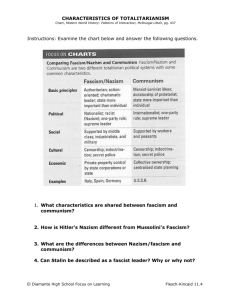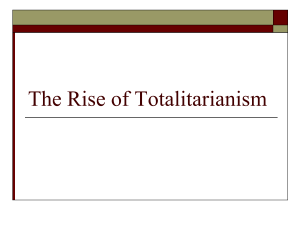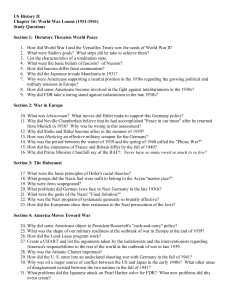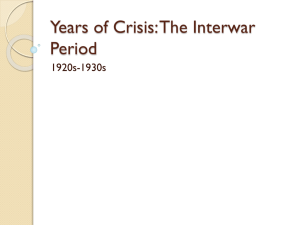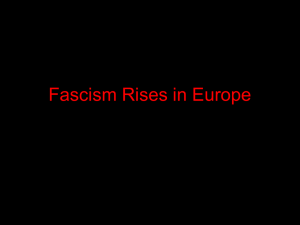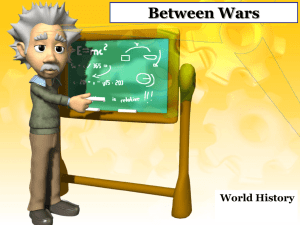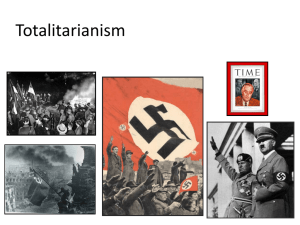Unit3PP1930s - mrsliftigsocialstudies
advertisement
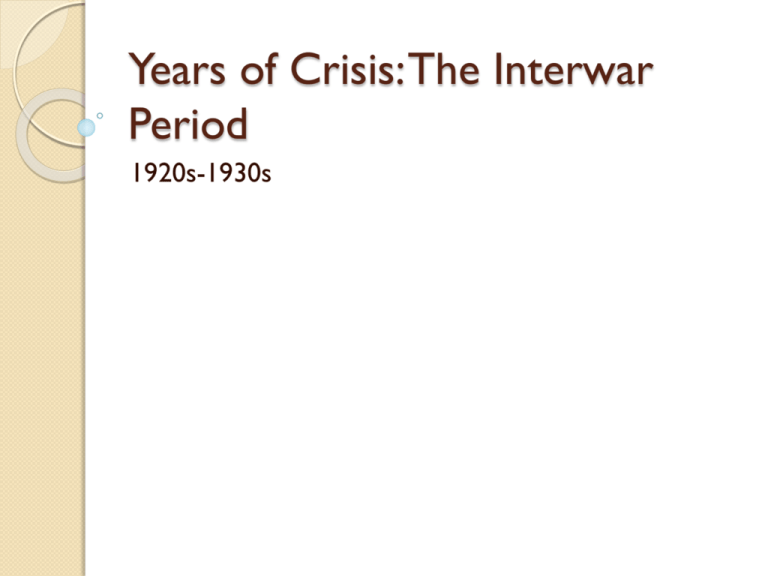
Years of Crisis: The Interwar Period 1920s-1930s Journal #18 What would life be like if you lived in a country where you did not have the freedom to choose what you buy, where you work, what you eat, or what you say. What would you miss the most? Competing ideologies of the 20th century Ideology: ◦ A system of ideas and beliefs Ideologies are “isms” Some you may know: atheism, capitalism, humanism, optimism, racism, idealism, imperialism Competing ideologies of the 20th century ◦ Totalitarianism: No freedom Fascism Communism ◦ Democracy: Freedom Totalitarianism Government takes control over every aspect of public and private life ◦ ◦ ◦ ◦ Charismatic leader Police terror Indoctrination (brainwashing youth) Propaganda Examples: ◦ Fascist Italy, Nazi Germany, Communist USSR Fascism Began in Italy after WWI Italians were not happy with the Treaty of Versailles Leader of the Fascist Party: Benito Mussolini ◦ “Party” is not a fun gathering! ◦ It is a group of people with similar political views and ideologies Mussolini Mussolini Takes Power ◦ Organizes Blackshirts (WWI veterans) to fight Communists and keep order in the streets ◦ October 1922: March on Rome King Victor Emmanuel II gave Mussolini power ◦ Il Duce: “The Leader” What does this tell you about fascism? Fascis, ancient Rome: Fascism “Fascism may be defined as a form of political behavior marked by obsessive preoccupation with community decline, humiliation or victimhood and by compensatory cults of unity, energy and purity, in which a massed-based party of committed nationalist militants, working in uneasy but effective collaboration with traditional elites, abandons democratic liberties and pursues with redemptive violence and without ethical or legal restraints goals of internal cleansing and external explansion.” (Paxton, op. cit., p. 218) Characteristics of fascism Obsessed with humiliation/victimhood Obsessed with unity and purity Extremely nationalist Focuses on “enemies”/racist Uses violence without restraint to: ◦ Expand the power/land of the country (outside) ◦ “Purify” the country (inside) Review! For each picture, write down what characteristic of fascism and/or totalitarianism it represents. Mussolini, Italy Nazi Propaganda: “Long Live Germany!” Hitler Youth: “Youth serves the Leader” White Rose Resistance, all executed Journal #18 Take out your Source Sheets for me to collect. List one aspect of either fascism or totalitarianism, without looking at notes! Cabaret: “Tomorrow Belongs to Me” As you watch, list: ◦ Verbal messages (what are they saying?) ◦ Actions (what are people doing?) ◦ Symbols/images you notice ◦ http://www.youtube.com/watch?v=bs5bnVoZ K4Q Nazism National Socialist German Worker’s Party (NSDAP) Leader of the Nazi Party: Adolf Hitler (der Fuhrer) 1923: Hitler failed to take over (Beer Hall Putsch) 1925: In jail, wrote Mein Kampf You have until lunch to finish your Nazi Party packets from yesterday. When you are done, write a specific characteristic of Nazism on the board. Specific Characteristics of Nazism Anti-semitism: Prejudice against Jews Volk: German people superior Lebensraum: Germans need “living space” Aryan: Best race (“master race”) Other people Nazis considered inferior: ◦ Poles, Roma (gypsies) ◦ Jehovah’s Witnesses, homosexuals, mentally disabled “Aryan Family” Anti-semitism: “The eternal Jew” Why anti-semitism? Connected with: ◦ ◦ ◦ ◦ Communism Money lending/banking Christian anti-Jewish history “New” ideas Sexual freedom Einstein Modern art Hitler’s Rise to Power Great Depression: Nazis become popular By 1932: Largest party in the Reichstag (German parliament) 1933: President Hindenburg names Hitler chancellor (head of parliament) Reichstag building is set on fire ◦ Hitler blames Communists ◦ Hitler takes “emergency powers” 1934: Death of Hindenburg leads to Hitler taking total control as the Fuhrer Anti-semitism Timeline 1933: Sterilization Laws 1935: Nuremberg Laws ◦ German Jews no longer citizens, cannot marry “Aryans” 1937: Jewish businesses taken 1938: Kristallnacht, “Night of Broken Glass” 1939: Deportation to concentration camps begins; euthanasia of “unfit” Other Dictatorships Peron in Argentina Franco in Spain Eastern European dictatorships Journal #19 1. What would life be like if you lived in a country where you did not have the freedom to choose what you buy, where you work, what you eat, or what you say. What would you miss the most? Why? 2. What is this kind of government called? 3. In your opinion, did Hitler come to power legally? Explain (and use your notes/textbook for help if you need it). Comparing Fascism and Communism Stalin Total control of government ◦ Killed political opponents or sent them to labor camps in the Great Purge (1937) ◦ Persecuted religious groups Total control of economy: Command economy ◦ Five Year Plans: To increase industrial production ◦ Made peasants work in collective farms; killed richer peasants (kulaks) Collective Farms Gulags Forced labor camps Stalin’s Propaganda Before… After… Journal #20 Communism and fascism are both totalitarian forms of government. What is one similarity and one difference? Think of the following categories to help you: ideology, leaders, political parties, economics, state vs. individual rights, role of the police Put one of your answers on the board. Japan Rises Read the article. Power of the military and the emperor Greater East Asia Co-Prosperity Sphere Nationalism and racism ◦ 1931: Invaded Manchuria ◦ 1933: Left the League of Nations ◦ 1937: Took over most of China; Nanking massacre Road to WWII Timeline: 1935: Mussolini invades Ethiopia 1936: Germany reoccupies the Rhineland ◦ Violation of the Treaty of Versailles Axis Powers formed ◦ Germany, Italy, Japan 1936-1939: Franco takes over Spain Road to WWII 1938: Hitler annexed (added) Austria into the Third Reich ◦ Anschluss 1938: Takes the Sudetenland 1939: Takes all of Czechoslovakia 1939: Stalin and Hitler sign a Nonaggression Pact Germany invades Poland; Britain and France declare war on Germany Attempts at Peace Why did they fail? Kellogg-Briand Pact (1928) outlawed war Munich Conference (1938) allowed Hitler to take the Sudetenland US isolationism: ◦ Did not join the League of Nations, wanted to be strictly neutral to avoid getting into another war European appeasement: ◦ Giving in to an aggressor to prevent war Journal # 21 1. Give your opinion… ◦ Do you think fascism could happen here in the United States? Explain. 2. How is a history thesis statement like a hypothesis in science? 3. If you would like class feedback on your thesis statement, write it on the board. Triumph of the Will (1934) As you watch, write in your journals: 1. What elements of fascism/totalitarianism does this clip show? 2. Are there any clues in this video that predict or foreshadow Hitler and Germany’s steps of aggression throughout the 1930s?
